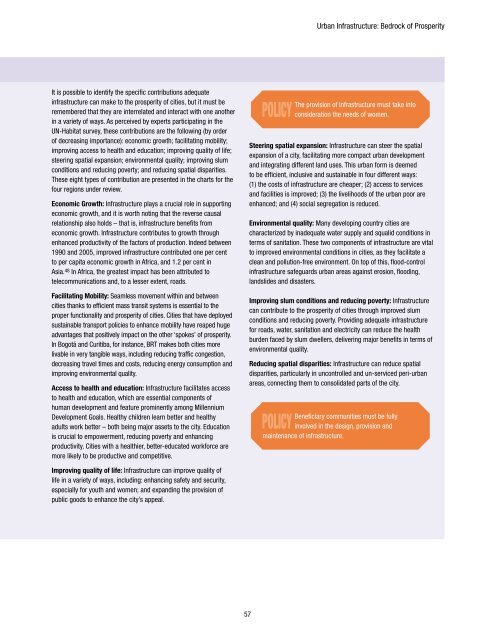Urban Infrastructure: Bedrock <strong>of</strong> ProsperityIt is possible to identify <strong>the</strong> specific contributions adequateinfrastructure can make to <strong>the</strong> prosperity <strong>of</strong> <strong>cities</strong>, but it must beremembered that <strong>the</strong>y are interrelated and interact with one ano<strong>the</strong>rin a variety <strong>of</strong> ways. As perceived by experts participating in <strong>the</strong>UN-Habitat survey, <strong>the</strong>se contributions are <strong>the</strong> following (by order<strong>of</strong> decreasing importance): economic growth; facilitating mobility;improving access to health and education; improving quality <strong>of</strong> life;steering spatial expansion; environmental quality; improving slumconditions and reducing poverty; and reducing spatial disparities.These eight types <strong>of</strong> contribution are presented in <strong>the</strong> charts for <strong>the</strong>four regions under review.Economic Growth: Infrastructure plays a crucial role in supportingeconomic growth, and it is worth noting that <strong>the</strong> reverse causalrelationship also holds – that is, infrastructure benefits fromeconomic growth. Infrastructure contributes to growth throughenhanced productivity <strong>of</strong> <strong>the</strong> factors <strong>of</strong> production. Indeed between1990 and 2005, improved infrastructure contributed one per centto per capita economic growth in Africa, and 1.2 per cent inAsia. 48 In Africa, <strong>the</strong> greatest impact has been attributed totelecommunications and, to a lesser extent, roads.Facilitating Mobility: Seamless movement within and between<strong>cities</strong> thanks to efficient mass transit systems is essential to <strong>the</strong>proper functionality and prosperity <strong>of</strong> <strong>cities</strong>. Cities that have deployedsustainable transport policies to enhance mobility have reaped hugeadvantages that positively impact on <strong>the</strong> o<strong>the</strong>r ‘spokes’ <strong>of</strong> prosperity.In Bogotá and Curitiba, for instance, BRT makes both <strong>cities</strong> morelivable in very tangible ways, including reducing traffic congestion,decreasing travel times and costs, reducing energy consumption andimproving environmental quality.Access to health and education: Infrastructure facilitates accessto health and education, which are essential components <strong>of</strong>human development and feature prominently among MillenniumDevelopment Goals. Healthy children learn better and healthyadults work better – both being major assets to <strong>the</strong> city. Educationis crucial to empowerment, reducing poverty and enhancingproductivity. Cities with a healthier, better-educated workforce aremore likely to be productive and competitive.policySteering spatial expansion: Infrastructure can steer <strong>the</strong> spatialexpansion <strong>of</strong> a city, facilitating more compact urban developmentand integrating different land uses. This urban form is deemedto be efficient, inclusive and sustainable in four different ways:(1) <strong>the</strong> costs <strong>of</strong> infrastructure are cheaper; (2) access to servicesand facilities is improved; (3) <strong>the</strong> livelihoods <strong>of</strong> <strong>the</strong> urban poor areenhanced; and (4) social segregation is reduced.Environmental quality: Many developing country <strong>cities</strong> arecharacterized by inadequate water supply and squalid conditions interms <strong>of</strong> sanitation. These two components <strong>of</strong> infrastructure are vitalto improved environmental conditions in <strong>cities</strong>, as <strong>the</strong>y facilitate aclean and pollution-free environment. On top <strong>of</strong> this, flood-controlinfrastructure safeguards urban areas against erosion, flooding,landslides and disasters.Improving slum conditions and reducing poverty: Infrastructurecan contribute to <strong>the</strong> prosperity <strong>of</strong> <strong>cities</strong> through improved slumconditions and reducing poverty. Providing adequate infrastructurefor roads, water, sanitation and electricity can reduce <strong>the</strong> healthburden faced by slum dwellers, delivering major benefits in terms <strong>of</strong>environmental quality.Reducing spatial disparities: Infrastructure can reduce spatialdisparities, particularly in uncontrolled and un-serviced peri-urbanareas, connecting <strong>the</strong>m to consolidated parts <strong>of</strong> <strong>the</strong> city.policyThe provision <strong>of</strong> infrastructure must take intoconsideration <strong>the</strong> needs <strong>of</strong> women.Beneficiary communities must be fullyinvolved in <strong>the</strong> design, provision andmaintenance <strong>of</strong> infrastructure.Improving quality <strong>of</strong> life: Infrastructure can improve quality <strong>of</strong>life in a variety <strong>of</strong> ways, including: enhancing safety and security,especially for youth and women; and expanding <strong>the</strong> provision <strong>of</strong>public goods to enhance <strong>the</strong> city’s appeal.57
State <strong>of</strong> <strong>the</strong> World’s Cities <strong>2012</strong>/<strong>2013</strong>Endnotes1 Choguill, C. (1996) “Ten steps to sustainable infrastructure”, Habitat International, Vol.20(3), pp. 389-4044; Teriman, S., T. Yigitcanlar, and S. Mayere (2010) ‘<strong>Sustainable</strong>urban infrastructure development in south east Asia : evidence from Hong Kong,Kuala Lumpur and Singapore’ in Yigitcanlar, T. (ed.) <strong>Sustainable</strong> Urban and RegionalInfrastructure Development : Technologies, Applications and Management, IGI Global,Hershey, Pennsylvania2 Lall, R., R. Anand and A. Rastogi (2010) ‘Developing physical Infrastructure: Acomparative perspective on <strong>the</strong> experience <strong>of</strong> China and India’, in Gerhaeusser K.,Iwasaki, Y. and V. B. Tulasidhar, (eds) Resurging Asian Giants’ Asian DevelopmentBank, Manila, pp.57-114.3 Fay, M. and M. Morrison (2005) Infrastructure in Latin America and <strong>the</strong> Caribbean:Recent Developments and Key Challenges, World Bank, Washington,DC.4 Foster, V., and C. Briceno-Garmendia (2010) Africa’s Infrastructure: A Time forTransformation, World Bank, Washington, DC.5 Belliapa, S.G. (2011) City Report on Bangalore. Unpublished UN-Habitat backgroundstudy for “State <strong>of</strong> <strong>the</strong> World’s Cities Report <strong>2012</strong>/13”6 Harris, C (2008) “India Leads Developing <strong>Nations</strong> in Private Sector Investment”,Gridlines, No.3, March 2008, http://www.pppinindia.com/pdf/gridlines.pdf7 Latin American Herald Tribune (2011) ‘Cuban Capital Faces Worst Water Shortage in50 Years’, Latin American Herald Tribune, http://laht.com/article.asp?ArticleId=391553&CategoryId=145108 López , M (2011) Water Distribution as an Indicator <strong>of</strong> Social Inequality: The Case <strong>of</strong>Medellín, Colombia, http://www.centrodametropole.org.br/static/uploads/marcela_l.pdf9 Shabou, A., N. Soboh, K. Jalouka, and D. A. Thaib (2011) City Report on Amman.Unpublished UN-Habitat background study for “State <strong>of</strong> <strong>the</strong> World’s Cities Report<strong>2012</strong>/<strong>2013</strong>”10 Karim, S. S.A. (2011) City Report on Basra. Unpublished UN-Habitat background studyfor “State <strong>of</strong> <strong>the</strong> World’s Cities Report <strong>2012</strong>/<strong>2013</strong>”11 Takechi, A (2010) Basrah Water Supply from viewpoint <strong>of</strong> Its Water Sources, http://www.waterforum.jp/jpn/iraq/doc/expert_meeting/session/4_2.pdf12 Although <strong>the</strong> region is <strong>the</strong> least provided in <strong>the</strong> world, with just 1.4 per cent <strong>of</strong> <strong>the</strong>planet renewable freshwater. {Roudi-Fahimi, F., L. Creel and R. M. De Souza (2002)Finding <strong>the</strong> Balance: Population and Water Scarcity in <strong>the</strong> Middle East and NorthAfrica, MENA Policy Brief, Population Reference Bureau, Washington, DC}13 The Arab State’s Region is host to 65 <strong>of</strong> <strong>the</strong> world’s 100 largest desalination plants.{Pacific Institute (2011) The World’s Water Volume 7: The Biennial Report onFreshwater Resources, Table 21, http://www.worldwater.org/data.html}14 The economic costs <strong>of</strong> traffic congestion are staggering: in <strong>the</strong> US in 2010 itwas put at $101 billion in terms <strong>of</strong> lost productivity and wasted fuel, or $713 percommuter per year; in Mauritius, traffic congestion in <strong>cities</strong> costs <strong>the</strong> economy 1.3per cent <strong>of</strong> GDP. {African Economic Outlook (2011) Mauritius: Overview, http://www.africaneconomicoutlook.org/en/countries/sou<strong>the</strong>rn-africa/mauritius/}15 Kumar , A., and F. Barrett (2008) Stuck in Traffic: Urban Transport in Africa, WorldBank, Washington, DC16 Kumar,A. (2011) Understanding <strong>the</strong> Emerging Role Of Motorcycles in AfricanCities: A Political Economy Perspective, Sub-Saharan Africa Transport PolicyProgram Discussion Paper No. 13, World Bank, http://siteresources.worldbank.org/EXTAFRSUBSAHTRA/Resources/1513929-1262811948762/DP13-Role-Motorcycles.pdf17 In 2007, Lagos had over 100,000 minibuses and 200,000 commercial motorcyclesdirectly employing 500,000 people. Kumar (2011)18 Kumar and Barrett (2008), op. cit.19 The network increased from 95,000 to 208,000 km from 1990 to 2003. Pucher etal (2007)20 McKinsey Global Institute (2009) Preparing for China’s Urban Billion, McKinsey andCompany.21 World Bank (2002) Cities on <strong>the</strong> Move: A World Bank Urban Transport StrategyReview, World Bank, Washington, DC.22 Pucher, J., Z. Peng, N. Mittal, Y. Zhu,and N. Korattyswaroopam (2007) ‘Urban transporttrends and policies in China and India: Impacts <strong>of</strong> rapid Economic growth’, TransportReviews, Vol. 27 (4), pp. 379–41023 Uddin, A. (2009) ‘Traffic Congestion in Indian Cities: Challenges <strong>of</strong> a Rising Power’,paper presented at <strong>the</strong> conference Kyoto <strong>of</strong> <strong>the</strong> Cities, Naples, March 26-28,2009, http://www.visionwebsite.eu/UserFiles/File/filedascaricare/Scientifci%20Partners,Papers(Kyoto)/Draft_koc_Azeem%20Uddin.pdf24 HPEC (2011) Report on Indian Urban Infrastructure and Services,National Institute <strong>of</strong>Urban Affairs, New Delhi25 Uddin, A (2009) op.cit.26 Estimated from World Bank (2011)27 Canassa, H. (2008) ‘São Paulo Traffic Jams Mean Lost Business, Stress, Helicopters’,Bloomberg, July 14, http://www.bloomberg.com/apps/news?pid=newsarchive&sid=aAwzOeXmIxgk28 Vicentini, V. L.(2010) ‘Lessons from urban transport in Latin America and <strong>the</strong>Caribbean’, presentation at <strong>the</strong> 2010 ADB Transport Forum, May 25-27, Manila;Luoma, J., M. Sivak and S. Zielinski (2010) The Future <strong>of</strong> Personal Transportation inMega<strong>cities</strong> <strong>of</strong> <strong>the</strong> World, Transportation Research Institute, University <strong>of</strong> Michigan,Ann Arbor29 Coyula, M. (2011) City Report on Havana. Unpublished UN-Habitat background studyfor “State <strong>of</strong> <strong>the</strong> World’s Cities Report <strong>2012</strong>/<strong>2013</strong>”30 Perez, F. (2011) City Report on Guadajara. Unpublished UN-Habitat background studyfor “State <strong>of</strong> <strong>the</strong> World’s Cities Report <strong>2012</strong>/<strong>2013</strong>”.31 ESCWA (2009) Transport for <strong>Sustainable</strong> Development in <strong>the</strong> Arab Region: Measures,Progress Achieved, Challenges and Policy Framework, <strong>United</strong> <strong>Nations</strong>, New York,http://www.uncclearn.org/sites/www.uncclearn.org/files/unescwa14.pdf32 World Bank (2011) World Development Indicators, World Bank, Washington, DC.33 Shariff, O. (2007) ‘Dubai Traffic Woes Inflict Losses <strong>of</strong> Dh4.6b a Year’, Gulf News,December 13, http://gulfnews.com/business/shipping/dubai-traffic-woes-inflictlosses-<strong>of</strong>-dh4-6b-a-year-1.75892;Raouf, M. A. (2009)’Towards sustainabletransportation’, Gulf News, September 18, http://gulfnews.com/opinions/columnists/towards-sustainable-transportation-1.53987234 Kollock, P. (2010) ‘Still Sitting in Beirut Traffic’, NOW Lebanon, May 5 http://www.nowlebanon.com/NewsArchiveDetails.aspx?ID=16612135 Shabou, A., N. Soboh, K. Jalouka, and D. A. Thaib (2011) op. cit.36 Raouf, M. A. (2009) op. cit.37 Al-Rawashdeh, A. (2011) “New bus system aims to reduce Amman’s trafficcongestion”, Al-Shorfa.com, January 26, http://al-shorfa.com/en_GB/articles/meii/features/main/2011/01/26/feature-0238 International Telecommunication Union (2010) World Telecommunication/ICTIndicators Database, http://www.itu.int/ITU-D/ict/statistics/39 GSM Association (2011a) Asia Pacific Mobile Observatory 2011, GSMA, London40 Aker, J. C. and I. M. Mbiti, (2010) ‘Mobile telephones and economic development inAfrica’, Journal <strong>of</strong> Economic Perspectives, Vol. 24(3), pp. 207-23241 GSM Association (2011b) Africa Mobile Observatory 2011, GSMA, London42 Philip, J. T. (2009) ‘Average Urban Teledensity Crosses 100% Mark’, The EconomicTimes, December 12, http://articles.economictimes.indiatimes.com/2009-12-12/news/28416388_1_cent-mark-mobile-connections-teledensity43 Centre for Livable Cities (2011) City Report on Singapore. Unpublished UN-Habitatbackground study for “State <strong>of</strong> <strong>the</strong> World’s Cities Report <strong>2012</strong>/<strong>2013</strong>”44 GSM Association (2011a) op. cit.45 Fernández-Ardèvol, M. (2010) ‘Household access to mobile telephony in LatinAmerica’, in Sevensson, J. and G. Wicander, (eds.): Proceedings <strong>of</strong> <strong>the</strong> 2ndInternational Conference on M4D,Mobile Communication Technology forDevelopment, 10-11 November, Kampala, Uganda, pp. 60-69.46 GSM Association (2011c) Latin American Mobile Observatory 2011, GSMA London47 Telecommunications and Regulatory Authority (2011) UAE TelecommunicationsSector Developments and Indicators, 2007 –2010.48 Calderón, C (2008) “Infrastructure and growth in Africa”, Policy Research WorkingPaper 4914, World Bank, Washington, DC58





